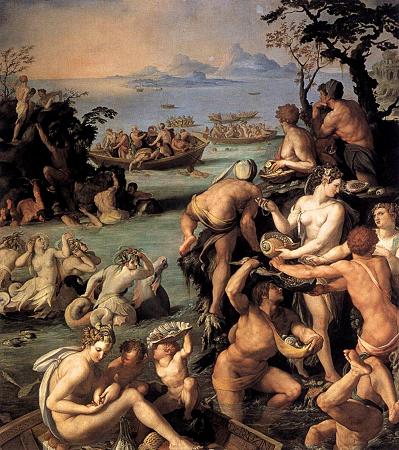Palazzo Vecchio. The Palazzo Vecchio is the town hall of Florence, Italy. It overlooks the Piazza della Signoria, which holds a copy of Michelangelo's David statue, and the gallery of statues in the adjacent Loggia dei Lanzi. Originally called the Palazzo della Signoria, after the Signoria of Florence, the ruling body of the Republic of Florence, this building was also known by several other names: Palazzo del Popolo, Palazzo dei Priori, and Palazzo Ducale, in accordance with the varying use of the palace during its long history. The building acquired its current name when the Medici duke's residence was moved across the Arno River to the Palazzo Pitti. In 1299, the commune and people of Florence decided to build a palace that would be worthy of the city's importance, and that would be more secure and defensible in times of turbulence for the magistrates of the commune. Arnolfo di Cambio, the architect of the Duomo and the Santa Croce church, began construction upon the ruins of Palazzo dei Fanti and Palazzo dell'Esecutore di Giustizia, once owned by the Uberti family. Giovanni Villani wrote in his Nuova Cronica that the Uberti were rebels of Florence and Ghibellines, stating that the palazzo was built to ensure that the Uberti family homes would never be rebuilt on the same location. The cubical building is made of solid rusticated stonework, with two rows of two-lighted Gothic windows, each with a trefoil arch. In the 15th century, Michelozzo Michelozzi added decorative bas-reliefs of the cross and the Florentine lily in the spandrels between the trefoils. The building is crowned with projecting crenellated battlement, supported by small arches and corbels. Under the arches are a repeated series of nine painted coats of arms of the Florentine republic. Some of these arches can be used as embrasures for dropping heated liquids or rocks on invaders. The solid, massive building is enhanced by the simple tower with its clock. Giovanni Villani wrote that Arnolfo di Cambio incorporated the ancient tower of the Foraboschi family into the new tower's facade as its substructure; this is why the rectangular tower is not directly centered in the building. This tower contains two small cells, that, at different times, imprisoned Cosimo de' Medici and Girolamo Savonarola. The tower is named after its designer Torre d'Arnolfo. The tower's large, one-handed clock was originally constructed in 1353 by the Florentine Nicolo Bernardo, but was replaced in 1667 with a replica made by Georg Lederle from the German town of Augsburg and installed by Vincenzo Viviani. Duke Cosimo I de' Medici moved his official seat from the Medici palazzo in via Larga to the Palazzo della Signoria in May 1540, signalling the security of Medici power in Florence. When Cosimo later removed to Palazzo Pitti, he officially renamed his former palace to the Palazzo Vecchio, the Old Palace, although the adjacent town square, the Piazza della Signoria, still bears the original name. Cosimo commissioned Giorgio Vasari to build an above-ground walkway, the Vasari corridor, from the Palazzo Vecchio, through the Uffizi, over the Ponte Vecchio to the Palazzo Pitti. Cosimo I also moved the seat of government to the Uffizi. The palace gained new importance as the seat of united Italy's provisional government from 1865-71, at a moment when Florence had become the temporary capital of the Kingdom of Italy. Although most of the Palazzo Vecchio is now a museum, it remains as the symbol and center of local government; since 1872 it has housed the office of the mayor of Florence, and it is the seat of the City Council. The tower currently has three bells; the oldest was cast in the 13th century. Above the front entrance door, there is a notable ornamental marble frontispiece, dating from 1528.
more...














